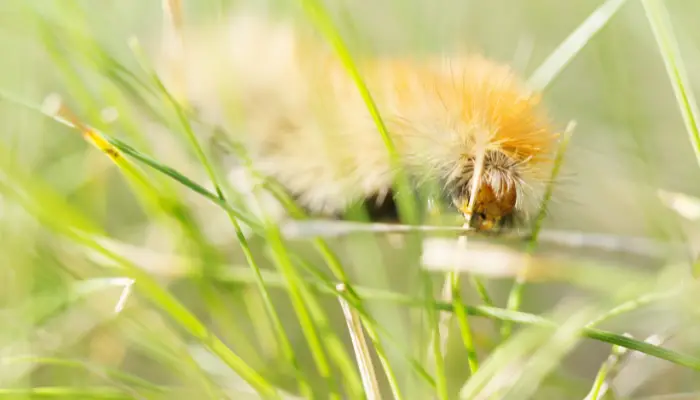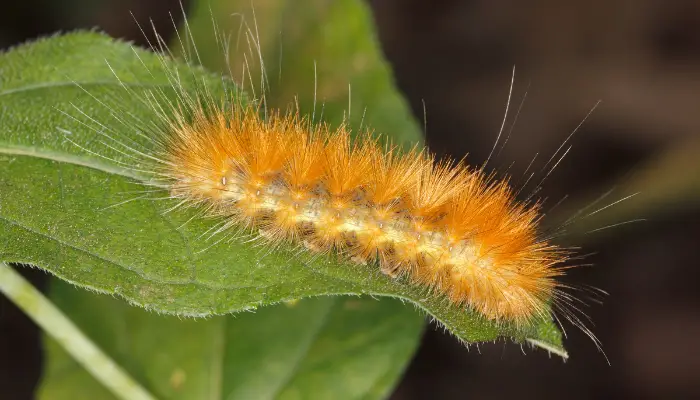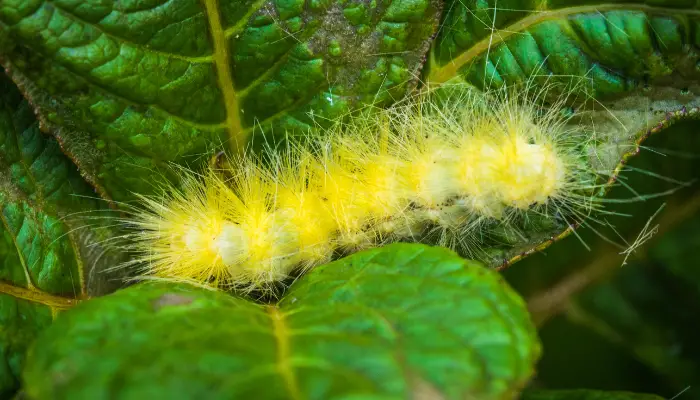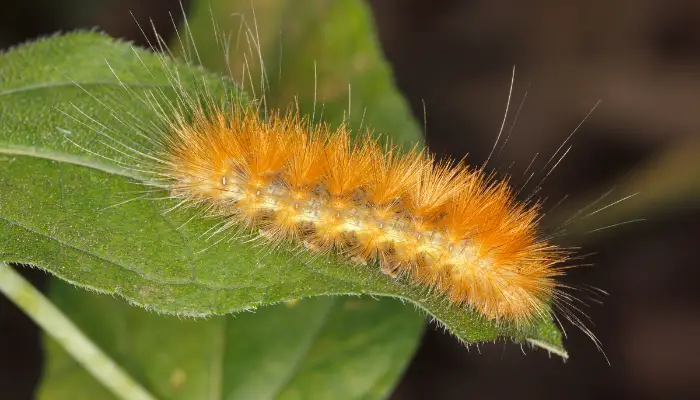Yellow Woolly Bear Caterpillar’s Life Cycle And Stages
Yellow woolly bear caterpillar’s life cycle.
Set against the backdrop of rustling leaves and soft outdoor sounds, this amazing animal’s story comes to life.
Let yourself be engrossed in the wonders of their existence as we explore each phase and take in the breathtaking changes that characterize their existence.
Let the adventure play out in front of your eyes!

Stage 1: The Egg
Picture yourself in a tranquil meadow, a serene backdrop where the miracle of life takes its first breath. Here, a meticulous mother Yellow Woolly Bear Caterpillar carefully lays her eggs on the underside of a lush green leaf.
Visualize the tiny, spherical eggs, each holding the promise of new life, delicately placed in anticipation of nature’s magic.
This is a moment of delicate beauty and potential, where the future of these caterpillars is entrusted to the nurturing embrace of their environment.
Feel the sense of anticipation as the eggs hatch, releasing tiny caterpillars into the world.
Witness the emergence of life as these minuscule creatures unfurl into existence, showcasing a vibrant burst of yellow against the verdant backdrop of their habitat.
Now, imagine being there with them, a witness to their first explorations, their tentative steps, and the curiosity that defines their early days.
Stage 2: Hatching and Early Instar
As these newborn caterpillars venture into the world, visualize it through their microscopic eyes.
Experience the world from the perspective of these tiny explorers, as they navigate the intricate maze of leaves, driven by an innate sense of wonder.
Observe the vibrant yellow hue that sets them apart, a visual testament to the uniqueness of their species.
Feel the softness of the leaves beneath their small bodies as they embark on their journey of discovery.
Witness their first encounters with the environment, as they explore their surroundings, munching on leaves that serve as their primary source of sustenance.
Dive into the intricacies of their early instar stage, a critical period of growth and adaptation.
Picture the delicate balance of nature at play, as these young caterpillars begin to establish their presence in the ecosystem.
Stage 3: Growth and Molting
Now, envision the world from the perspective of the Yellow Woolly Bear Caterpillar as it undergoes a phase of rapid growth and molting.
Picture the transformative moments as the caterpillar sheds its old skin, revealing a larger, more developed form beneath.
Feel the pulsating energy of growth, an unstoppable force that propels these creatures toward their next phase of life.
Observe the changes in their physical appearance with each molting stage.
Picture the intricate dance between growth and molting, a continuous cycle that shapes their bodies and readies them for the challenges ahead.
You’re part of the process, intimately connected to the subtle nuances of their development.
Stage 4: Pupa Formation
Now, imagine the world through the eyes of the caterpillar as it enters the mystical pupal stage.
Feel the excitement as it carefully selects a suitable location to undergo this transformative process within the confines of a protective cocoon.
Picture the meticulous weaving of the cocoon, a temporary sanctuary that cradles the caterpillar during this crucial stage of metamorphosis.
Experience the suspense of the pupal stage, a quiet interlude before the grand transformation.
Within the cocoon, a metamorphic spectacle unfolds, preparing the caterpillar for its final act of becoming an adult.
Feel the energy building up, the anticipation of what lies beyond the veil of the cocoon.
Stage 5: Metamorphosis into Adult Moth
As the pupa undergoes its metamorphic journey, picture the emergence of the adult Yellow Woolly Bear Moth.
Imagine the delicate moment as it breaks free from the cocoon, unfurling its wings to reveal a stunning adult form.
Feel the sheer marvel of metamorphosis, a testament to the resilience and adaptability of these incredible creatures.
Step into the world of the adult moth as it adapts to its new surroundings.
Visualize the flutter of wings, the gentle brush of air as the Yellow Woolly Bear takes flight.
Experience the world through the eyes of this newly transformed creature, navigating the challenges of its environment with grace and poise.
Adaptations for Survival

Now, put yourself in the shoes of the Yellow Woolly Bear Caterpillar, exploring the various strategies it employs for survival.
Picture the world from the perspective of a creature adorned with a vibrant yellow hue, utilizing ingenious camouflage techniques to blend seamlessly with its surroundings.
Feel the adrenaline as it deploys defensive mechanisms against predators, a ballet of survival that underscores the resourcefulness of these creatures.
Transition into the adult phase and experience the world from the perspective of the Yellow Woolly Bear Moth.
Picture its nocturnal escapades, guided by instinct and enhanced features that ensure its survival in the wild.
You’re there, navigating the challenges of the environment and celebrating the adaptations that make these moths true marvels of evolution.
Environmental Factors Influencing Yellow Woolly Bear Caterpillar’s Life Cycle
Discover the profound influence of environmental factors as you delve deeper into the nuances of the life cycle of the Yellow Woolly Bear Caterpillar.
See how temperature, climate, and habitat dance delicately to shape these creatures’ fates.
Feel the ebb and flow of nature and recognize the delicate balance that keeps these creatures alive in the vast ecosystem.
From your vantage point, observe the influence of human-induced changes on the Yellow Woolly Bear’s habitat.
Picture the ripple effect of conservation efforts, understanding the interconnectedness of all living beings.
You’re an integral part of the ecosystem, and your awareness contributes to the preservation of these delicate life cycles.
Observing Yellow Woolly Bear Caterpillars in the Wild

When you set out on your own to observe Yellow Woolly Bear Caterpillars, picture the excitement of finding them in their native environment.
See yourself standing in the middle of a meadow, armed with curiosity and an elevated sense of amazement. You are not just a bystander; you are a part of the citizen science community.
Feel the joy of contributing to our understanding of these creatures.
Visualize the meticulous documentation of your observations, a valuable contribution to the collective knowledge of entomology.
You’re making a difference, one caterpillar at a time, and your involvement enriches the understanding of these enchanting beings.
Wrap Up
As we reach the conclusion of this extraordinary journey, take a moment to reflect on the marvels of the Yellow Woolly Bear Caterpillar’s life cycle.
Picture the cyclical dance of birth, growth, and transformation that defines their existence.
You’re not merely a spectator; you’re an explorer, connected to the intricate web of life that surrounds us.
Feel the sense of responsibility to protect and preserve the habitats that sustain these remarkable creatures.
Picture a future where the Yellow Woolly Bear Caterpillar continues to enchant generations with its awe-inspiring life cycle.
Your understanding and appreciation contribute to the tapestry of biodiversity, ensuring that these tiny wonders endure for generations to come.
Frequently Asked Questions Exploring the Yellow Woolly Bear Caterpillar’s Life Cycle
Q1: How long does the Yellow Woolly Bear Caterpillar’s life cycle typically last?
A1: The duration of the Yellow Woolly Bear Caterpillar’s life cycle can vary, but on average, it takes several weeks to complete. Factors such as temperature, climate, and available food sources can influence the timeline.
Q2: Where can I find Yellow Woolly Bear Caterpillars in the wild?
A2: Yellow Woolly Bear Caterpillars are often found in meadows, grasslands, and open wooded areas. Look for them on low-growing vegetation, especially on plants that serve as their preferred food source.
Q3: What do Yellow Woolly Bear Caterpillars eat during their early instar stage?
A3: In their early instar stage, Yellow Woolly Bear Caterpillars typically feed on a variety of low-growing plants. They are known to consume grasses, dandelion leaves, and other herbaceous vegetation.
Q4: Are Yellow Woolly Bear Caterpillars harmful to plants in my garden?
A4: While Yellow Woolly Bear Caterpillars do feed on vegetation, they are generally not considered harmful in moderate numbers. In fact, they play a role in the ecosystem by contributing to nutrient cycling and providing food for other organisms.
Q5: How can I create a caterpillar-friendly garden in my backyard?
A5: To establish a caterpillar-friendly garden, consider planting a variety of native plants that serve as host plants for caterpillars. Provide a diverse range of vegetation to support different stages of their life cycle. Avoid using pesticides to maintain a healthy and natural environment.
Q6: What are the main predators of Yellow Woolly Bear Caterpillars?
A6: Yellow Woolly Bear Caterpillars face threats from various predators, including birds, spiders, and certain insects. Their vibrant yellow coloration serves as a form of camouflage, but they also employ defensive mechanisms to deter predators.
Q7: Can I keep Yellow Woolly Bear Caterpillars as pets?
A7: While it might be tempting to keep Yellow Woolly Bear Caterpillars as pets, it’s important to consider their natural habitat and the complexities of their life cycle. It is generally recommended to observe them in the wild, contributing to citizen science efforts, rather than attempting to keep them in captivity.
Q8: How can I get involved in citizen science projects related to caterpillars?
A8: There are several citizen science projects that focus on caterpillar observations. Online platforms and organizations often provide resources for documenting and sharing your observations. Check with local nature groups or scientific organizations for opportunities to contribute to caterpillar research.
Q9: Are Yellow Woolly Bear Moths strictly nocturnal?
A9: Yes, Yellow Woolly Bear Moths are primarily nocturnal, meaning they are most active during the nighttime. Their nocturnal behavior is an adaptation that helps them avoid daytime predators.
Q10: Are there any conservation efforts focused on Yellow Woolly Bear Caterpillars?
A10: Conservation efforts often center around preserving the habitats where Yellow Woolly Bear Caterpillars thrive. Supporting initiatives that promote habitat conservation, biodiversity awareness, and sustainable environmental practices indirectly contributes to the well-being of these fascinating creatures.








